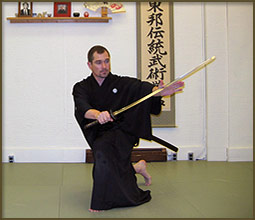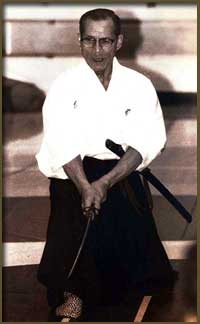|
|
Etiquette and the Code of the Samurai
From The Art of Japanese Swordsmanship, by Nicklaus Suino
Weatherhill/Shambhala; Boston, 1994.

One of the first tasks facing any leader of fighting men is that of instilling discipline in his troops. This was especially important for the Japanese, since the samurai were part of an elite social group and were expected to deport themselves in accordance with their position. They were schooled in Confucian classics and taught how to behave within the rigid guidelines of Japan.s ruling class. Any transgression of the rules was considered a serious problem, since every warrior in the retinue of a leader was considered a representative of his master. A breach of etiquette could easily lead to a duel, and hence death, or to war between two factions.

The close relationship between etiquette and the proper bearing of a martial artist is something that is not well understood today. Most people who practice martial arts assume that the concept of reishiki (etiquette) extends no further than the bow at the beginning of practice, or the use of the title sensei for their teacher. With this limited understanding of the concept, it is easy to see why such people don.t realize how closely linked etiquette is to bushido, the code of the samurai. The word bushido calls to mind warriors making great efforts to serve their lords in times of trouble. During famine, a samurai might not have eaten for weeks because his master needed the food for some other purpose. He might have walked a hundred miles overnight to deliver an important message. One of the most common stories from feudal times is of some samurai fighting a gallant battle in his lord.s name, only to be slain at the end.
Of course, it is not the aim of the warrior to die. His aim is to help his side win and, for that, his every action during combat must be correct. Any mistake means death. Constant vigilance is required; any expression of fear or self-interest lead to disaster. On the battlefield, bushido means doing what is correct at every moment, regardless of one.s feelings. The most successful warriors are those who can focus their attention completely on the task at hand. This is the discipline of the battlefield.
Since battles seldom continue for more than a short time, however, the question then becomes: how does a leader instill this discipline in his men when there is no battle? There are mock battles, of course, and all sorts of military exercises that help to teach the principles of combat, but instilling the correct attitude is extremely difficult.
 For the samurai, it turned out, a tool for teaching the correct attitude was already in place. Bushido was not confined to the battlefield, but actually governed their existence twenty-four hours a day. In times of peace, since every action was relevant to the status of their clan, it was required that they behave impeccably. In everyday society, this was nothing other than the application of reishiki, or correct etiquette. They had to do what was correct at all times, regardless of their feelings. Behaving this way day after day, with many social pressures reminding them of the importance of correct action, they eventually developed an ability to sense what was correct, and an aptitude for doing it. In fact, it is hard to imagine a better definition of character improvement.the commonly stated purpose of martial arts training.than this: learning to sense what is correct, and developing an aptitude for doing it. This is what budo is supposed to teach. The tools for teaching it have existed as long as have the samurai. Since, however, we live in a relatively peaceful society, the battlefield aspect is not available to us, so the peacetime aspect, reishiki, becomes all the more important.
For the samurai, it turned out, a tool for teaching the correct attitude was already in place. Bushido was not confined to the battlefield, but actually governed their existence twenty-four hours a day. In times of peace, since every action was relevant to the status of their clan, it was required that they behave impeccably. In everyday society, this was nothing other than the application of reishiki, or correct etiquette. They had to do what was correct at all times, regardless of their feelings. Behaving this way day after day, with many social pressures reminding them of the importance of correct action, they eventually developed an ability to sense what was correct, and an aptitude for doing it. In fact, it is hard to imagine a better definition of character improvement.the commonly stated purpose of martial arts training.than this: learning to sense what is correct, and developing an aptitude for doing it. This is what budo is supposed to teach. The tools for teaching it have existed as long as have the samurai. Since, however, we live in a relatively peaceful society, the battlefield aspect is not available to us, so the peacetime aspect, reishiki, becomes all the more important.
The most obvious expression of etiquette in the dojo is the rei, or bow. There are many other facets, as well, such as correct and safe handling of the sword, proper treatment of training partners, maintenance of equipment, and decorum. Each is one aspect of the larger general picture, which is harder to teach since it is more abstract. Actually understanding the principle is the goal, but not every student can make such progress. It is most important, for safety in practice and setting the correct example, however, that a student behave correctly. The basics, beside the rules of good manners that apply anywhere, are correct bowing and correct sword handling.
From The Art of Japanese Swordsmanship, by Nicklaus Suino
Weatherhill/Shambhala; Boston, 1994.
|